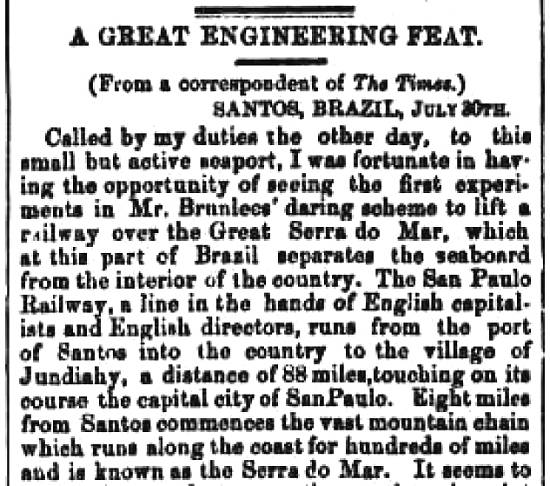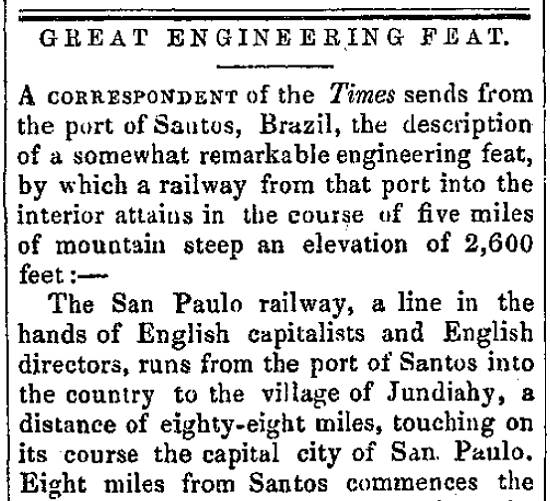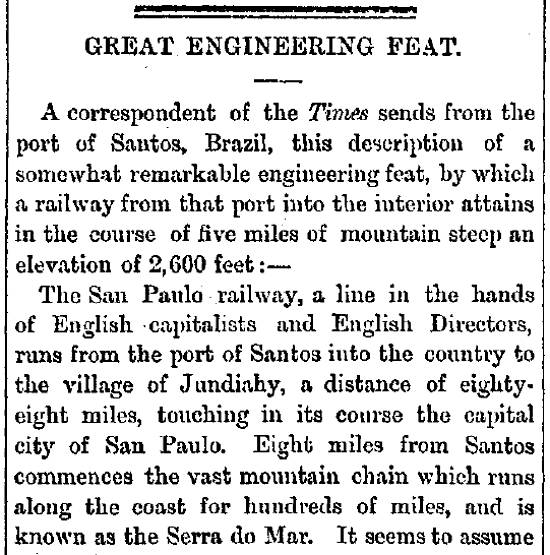|

Graças
às recentes iniciativas da Biblioteca Nacional da Austrália de digitalizar os principais jornais daquele
país de 1803 a 1854, acompanhada também pela Biblioteca Nacional da Nova Zelândia com
publicações de 1839 a 1932, é possível pesquisar essas coleções via Internet e encontrar notícias referentes a Santos nos séculos XIX e XX. A
construção pelos ingleses da imponente ferrovia São Paulo Railway não poderia passar despercebida, sendo comentada antes
mesmo de sua inauguração em 1865, como se verifica pela notícia do jornal The Sydney Morning Herald (publicado desde 1842 na cidade de
Sidney, New South Wales), na edição de 29 de novembro de
1864 (página 5):

|
 |
A GREAT
ENGINEERING FEAT IN CONNECTION WITH RAILWAYS.
(From a Correspondent of the Times)
Santos, Brazil,
July 30.
Called by my duties
the other day to this small but active seaport, I was fortunate in having the opportunity of seeing the first experiments in Mr. Brunlees'
daring scheme to lift a railway over the great Serra do Mar, which at this part of Brazil separates the seaboard from the interior of the
country. The Sao Paulo Railway, a line in the hands of English capitalists and English directors, runs from the port of Santos into the
country to the village of Jnndiahy, a distance of eighty-eight miles, touching on its course the capital city of San Paulo.
Eight miles from
Santos commences the vast mountain chain which runs along the coast for hundreds of miles, and is known as the Serra do Mar. It seems to
assume its grandest proportions at the only point where the province of San Paulo can be entered from the sea, and it is at this point that
science has been called upon to grapple with the tremendous dificulty of crossing the dividing range by a railway which attains in the course
of five miles of mountain steep an elevation of 2600 feet.
The conquest of
this enormous difficulty by the skill of the engineer opens up the most important province in Brazil to easy access from without, and will
give a rapid and cheap means of exit to the boundless products of a coffee-growing country, fertile beyond example. These facts give a special
importance to the railway and its wonderful passage over the Cordelheira. In the province, the undertaking is a much-engrossing topic, and the
Imperial Government of Brazil, pledged to a guarantee of 7 per cent on the capital outlay, watches with interest these important works as they
approach completion, an event now happily not far distant.
It was notified in Santos that his Excellency the President of the province had received Imperial commands to visit the works on the incline
over the Serra, about which scientific speculation had been so active, in order to observe and report to the Government as to the experiments
about to be made for ascending the first "lift" by motive power. The town became very animated and on the morning when the ascent was to be
made the President and his staff were joined by about 300 inhabitants of the place, and were received at the station by the chief resident
engineer and the company's agent, and conveyed by train to the foot of the Cordelheira.
From Santos to the
commencement of the ascent, the railway runs over a swampy country, wretchedly rotten, and reeking with miasma, till, crossing the Cubatao
River, eight miles from the sea, it approaches, by a woody defile in the rocks, the gorge up which it has to climb, till, 2600 feet above, it
passes out through an opening in the heights on the "campos", over which it runs on into the interior of the province. It is this enormous
ascent which gives to the undertaking its emphatic character. Passing the Mugy river, and at each step becoming more and more confined, the
black defiant ravine is suggestive of anything rather than an outlet for a railway course, which goes winding and ascending, crossing mountain
torrents, leaping gloomy chasms, cutting through solid rocks, still working upwards, till at length after five miles of such Titanic effort,
it passes out on to the "open".
Your readers will gather from this some idea of this daring scheme - so daring, indeed, and so hopeless has it looked, as to be laughed at and
voted a thing among engineering impossibilities. The Brazilian could not realize the constancy of human effort tearing a railway from the
sides of the rocks and carrying it away up into the clouds. The thing has, however, been done, and hence the interest shown by the good folks
of Santos, who were naturally enough curious to accompany the President to the slopes of the Serra that they might see the process by which
henceforth they are to be carried over the Cordelheira into the smiling province beyond. Permit me to explain briefly how this transit is to
be accomplished.
The entire ascent is divided into four "lifts", or inclines, of a mile and a quarter each, running at a gradient of 1 in 10. A level platform
or "bank-head", marks the summit of each incline, and at the upper end of the platform is a stationary engine. This engine has double
cylinders of 26-inch diameter, with a 5-foot stroke, and has been calculated to haul up fifty tons at the rate of ten miles per hour. Five
boilers of the Cornish description are placed wich each engine. On the upper half of each incline there is a double line of rails, with
arrangements for passing places on the middle of each of these "lifts".
A single line of
rails then runs on from the centre to the foot of each of the four divisions into which the ascent is divided. A steel wire rope, 1 1/2 inch
diameter, is made for pulling up the ascending trains. This rope, tested to a weight far exceeding the requirements that will be made upon it,
passes over friction wheels, and is attached to the fly-wheel shaft. The inclines are therefore partially self-acting, at the same time
passing one train down to the foot of the Serra, and drawing up another to the higher level on its way out to the province beyond.
The above description of one of these inclines will serve for the whole. The mechanical contrivance is in each case substantially the same,
and the nature of the steep over which the line passes varies very little. Everywhere, a wild, defiant, frowning majesty marks the scenery
through which these wonderful inclines wind their serpentine way. On the third division, however, there is a ravine, more gloomy than any
other. This "Boca do Inferno", for so it is called, is 900 feet in span on the level of the railway, and is crossed by a viaduct resting upon
clusters of iron columns, which spring up from enormous stone piers 200 feet below the centre of the line which passes over them.
The "Boca do
Inferno" is now alive with human activity, which loads the air with music; men are swarming in the clefts of the rock at every available point,
and great efforts are being made to connect the two sides of the ravine, so that trains may pass over it, and the whole ascent may be made
ready for the public. The completion of the four divisions of the incline is therefore not very far distant. The first division is in
operation, and it was to witness the inaugural experiments that the Brazilian Government had commander the presence of the President and his
official staff on the day when I passed by permission over the inclines with the rest of the company.
Passing the Mugy river and reaching the foot of the Serra, there was a little delay while the locomotive was uncoupled, and the train was
attached to the rope by which we were to be hauled up into the cloudy levels above us. You can well imagine the restless curiosity of the
company, and the desire manifested on all hands to know about the process going on around us. When information can be had by asking for, the
Brazilian commences the pursuit of knowledge with very becoming zest, and here the company's agents, the contractors, and all the officials,
showed a ready willingness to meet their friends half way.
Soon, however, the
train was got into motion, and by slow hesitating paces we commenced our ascent. Presently the speed improved and the motion became smoother,
and in eight minutes we were on the level platform which forms the "bank-head" of the first lift of the incline, having passed at the centre
point the down-train, which was running on to the level below. Once or twice on our ascent the train came to a standstill, and the ascending
and descending carriages were suspended and held fast midway on their courses, by way of demonstrating the absolute safety and control in
which all the operations were held by those who had charge of the machinery on the levels above us.
Arriving at the summit, the President proceeded to examine in a very minute manner the machinery and all the details by which the inclines
will have to be worked, taking note of the accommodation for receiving and dispatching ascending and descending trains, and making searching
inquiries into the bearings of all he saw passing before him. The entire party seemed to participate in his desire to know as much as
possible, and officials everywhere were fully employed in meeting the demands made upon them. The ascent has been in the highest degree
satisfactory, and at the conclusion of the trials and examinations made by the President, his Excellency expressed his sincere pleasure at
what he had seen, and his conviction that an immense, almost an insuperable difficulty, bad been completely vanquished by the daring skill and
persistent efforts of engineering science.
In the evening the
party returned to Santos, and seemed in a very emphatic spirit to endorse the opinion of the President as to the results of the experiments
they had witnessed on the Cordelheira. Some eighteen months will yet be required, however, to complete the line on its entire length of
eighty-eight miles to Jundiahy. In the meantime, its immediate extension to the city of Campinas is occupying the attention of the province,
and is, I am told, under the consideration of the Imperial Government. Mr. Brunlees, the chief engineer, having already submitted plans for
the inspection of competent authority. Campinas is the legitimate terminus of this line. Jundiahy is but a small and unimportant village,
while Campinas is the centre of the finest coffee-producing district in Brazil. The importance, therefore, of this city as a terminus is
evident, and indeed till it has been reached, shareholders will not know the value of their investments, and managers will not have sounded
the resources of the country into which the line runs. Meanwhile in Europe the success of the engineer in his attempt to cross the Serra del
Mar will be read with satisfaction, as a conquest won by science in a district yet new to commercial enterprise. |
Tradução livre
aproximada:
Uma grande façanha de
engenharia em conexão com ferrovias.
(De um correspondente do Times)
Santos, Brasil, 30 de
julho.
Chamado pelos meus deveres
no outro dia a este pequeno porto, mas ativo, eu estava feliz em ter a oportunidade de ver os primeiros experimentos em esquema ousado de Mr.
Brunlees para levantar uma estrada de ferro sobre a grande Serra do Mar, que nesta parte do Brasil separa o litoral do interior do país. A São Paulo
Railway, uma linha nas mãos dos capitalistas ingleses e diretores ingleses, corre a partir do porto de Santos para o país para a aldeia de Jundiaí,
uma distância de 88 milhas, tocando em seu curso na cidade capital de São Paulo.
A oito quilômetros de Santos
começa a vasta cadeia de montanhas que corre ao longo da costa por centenas de quilômetros, e é conhecida como a Serra do Mar. Parece que assume as
suas grandiosas proporções no único ponto onde a província de São Paulo pode ser atingida a partir do mar, e é neste ponto que a ciência tem sido
chamada a lidar com a tremenda dificuldade de atravessar a faixa divisória de uma estrada de ferro, que alcança no decurso de cinco quilômetros de
uma montanha íngreme elevação de 2.600 pés.
A conquista desta enorme
dificuldade pela habilidade do engenheiro abre a província mais importante do Brasil para acesso fácil a partir de fora, e dará um meio rápido e
barato de saída de produtos sem limites de um país de cultivo de café, além de férteis exemplos. Esses fatos dão uma importância especial para o
transporte ferroviário e sua passagem maravilhosa sobre a Cordilheira. Na província, a empresa é um tema muito cativante, e o Governo Imperial do
Brasil, comprometido a uma garantia de 7 por cento sobre as despesas de capital, com juros, assiste com interesse essas obras tão importantes se
aproximarem da conclusão, um evento agora felizmente não muito distante.
Foi notificado em Santos que
Sua Excelência o Presidente da Província recebeu ordens imperiais para visitar as obras do inclinado sobre a Serra, sobre o qual a especulação
científica foi tão ativa, a fim de observar e relatar ao Governo quanto à experiência prestes a ser feita para subir no primeiro "elevador" por
força motriz. A cidade tornou-se muito animado e pela manhã, quando a subida estava a ser feita, ao Presidente e sua equipe se juntaram cerca de 300
habitantes do lugar, e foram recebidos na estação pelo engenheiro residente-chefe e um agente da empresa, e enviados por trem ao pé da Cordilheira.
De Santos ao início da subida, a estrada corre sobre um país pantanoso, miseravelmente podres e cheirando com miasma, até que, atravessando o rio
Cubatão, oito milhas do mar, que se aproxima, por um desfiladeiro arborizado nas rochas, até a garganta que ele tem que subir, até que, 2.600 pés
acima, ele passa através de uma abertura na altura de "Campos", pela qual ele pode atingir o interior da província. É esta subida enorme, que dá à
empresa o seu caráter enfático. Passando o rio Mogi e, em cada passo cada vez mais confinada, a desafiadora ravina negra é sugestiva de alguma
coisa: ao invés de uma saída para um curso de transporte ferroviário, que vai se enrolando e ascendendo, cruzando torrentes de montanha, saltando
abismos sombrios, cortando rochas sólidas, ainda se esforçando para cima, até que finalmente, depois de cinco quilômetros de tal esforço titânico,
ele ultrapassa a abertura.
Seus leitores terão a partir disso formado alguma idéia do presente regime de ousadia - tão ousado, de fato, que parecia impossível, sendo
ridicularizado e votado como uma coisa entre as impossibilidades da engenharia. O brasileiro não conseguia perceber a constância do esforço humano,
rasgando uma estrada de ferro a partir dos lados das rochas e carregá-la até as nuvens. A coisa, no entanto, foi feita e, portanto, o interesse
demonstrado pela boa gente de Santos, que estava naturalmente bastante curiosa para acompanhar o Presidente a uma das colinas da Serra para que
pudessem ver o processo pelo qual, doravante, serão transportados sobre a Cordilheira além da sorridente província. Permitam-me explicar brevemente
como este trânsito está sendo realizado.
A subida inteira é dividida
em quatro "elevadores", ou inclinados, de uma milha e um quarto cada, funcionando em um gradiente de 1 em 10. O nível da plataforma ou "cabeça" do
banco, marca o cume de cada inclinação, e na extremidade superior da plataforma há um motor estacionário. Este motor tem cilindros de duplo diâmetro
de 26 polegadas, com um curso de 5 pés, e foi calculado para transportar até cinqüenta toneladas, à taxa de dez quilômetros por hora. Cinco
caldeiras do tipo Cornish são colocadas que cada motor. Na metade superior de cada declive existe uma linha de trilhos dupla, com modalidades de
passagem de lugares no meio de cada um desses "elevadores".
A única linha de trilhos, em
seguida, executada a partir do centro para o pé de cada um das quatro divisões em que a subida é dividida. Uma corda de aço, 1 1/2 polegada de
diâmetro, é usada para puxar para cima os comboios ascendentes. Este cabo, testado com um peso muito superior as exigências que serão feitas em cima
dele, passa por cima de rodas de atrito, e é ligado ao eixo do volante. Os inclinados são, portanto, parcialmente auto-acionados, ao mesmo tempo que
passa um trem até o sopé da Serra, puxa-se outro para o nível mais alto em seu caminho para o interior da província.
A descrição acima de um desses inclinados servirá para todos. O dispositivo mecânico é em cada caso, sensivelmente o mesmo, e a natureza íngreme em
que a linha passa varia muito pouco. Por toda parte, uma selvagem, desafiante, carrancuda majestade marca o cenário através do qual estes
maravilhosos inclinados fazem seu sinuoso caminho. Na terceira divisão, porém, há uma ravina, mais sombria do que qualquer outra. Esta "Boca do
Inferno", como é chamada, tem 900 pés de extensão sobre o nível da ferrovia, e é atravessada por um viaduto repousando sobre conjuntos de colunas de
ferro, que brotam de enormes bases de pedra 200 pés abaixo do centro da linha que passa sobre elas.
A "Boca do Inferno" está agora viva com a atividade humana, que carrega o ar com música; os homens estão fervilhando nas fissuras da rocha em todos
os pontos disponíveis, e grandes esforços estão sendo feitos para ligar os dois lados da ravina, de modo que os trens possam passar sobre ela, e
toda a ascensão possa ser preparada para o público. A conclusão das quatro divisões do inclinado, portanto, não está muito distante. A primeira
divisão está em operação, e foi para testemunhar as experiências iniciais que o governo brasileiro ordenou a presença do presidente e sua equipe
oficial no dia em que passei com permissão ao longo dos inclinados, com o resto da companhia.
Passando o rio Mogi e chegando ao pé da Serra, houve uma pequena demora, enquanto a locomotiva era desacoplada, e o trem era preso ao cabo pelo qual
seríamos transportado até os níveis muito nublados acima de nós. Você pode imaginar a curiosidade inquieta da companhia, bem como o desejo
manifestado em todas as mãos para saber sobre o processo realizado à nossa volta. Quando a informação pode ser obtido perguntando-se por ela, os
brasileiros iniciam a busca do conhecimento, com cada vez mais entusiasmo, e aqui os agentes da companhia, os contratantes, e todos os funcionários,
mostram o pronto desejo de atender seus amigos no meio do caminho.
Logo, porém, o trem começou a se movimentar, e com lentos passos hesitantes nós começamos nossa subida. Agora a velocidade aumentou e o movimento se
tornou mais suave, e em oito minutos estávamos no nível da plataforma que constitui o "banco principal" do primeiro elevador da inclinação, tendo
passado no ponto central o comboio de descida, que estava seguindo para o nível abaixo. Uma ou duas vezes em nossa subida no trem houve uma parada,
e os vagões ascendentes e descendentes ficaram suspensos a meio caminho em rápida manobra em seus cursos, para demonstrar a absoluta segurança e o
controle em todas as operações foram realizadas por aqueles que se encarregavam das máquinas nos níveis acima de nós.
Chegando ao topo, o
Presidente passou a examinar de forma muito minuciosa a máquina e todos os detalhes de como o inclinado terá de trabalhar, tomando nota da
acomodação para o recebimento e expedição de comboios subindo e descendo, e perguntando sobre os rolamentos, de tudo o que ele viu passar diante
dele. O grupo inteiro pareceu participar no seu desejo de conhecer, tanto quanto possível, e os funcionários em toda parte foram integralmente
utilizados no atendimento às demandas que lhes eram feitas. A subida foi no mais alto grau satisfatório, e na conclusão dos ensaios e exames feitos
pelo Presidente, Sua Excelência expressou seu sincero prazer no que ele tinha visto, e sua convicção de que uma imensa dificuldade, quase
insuperável, tinha sido completamente vencida pela habilidade, ousadia e os persistentes esforços da ciência da Engenharia.
À noite, o grupo regressou a Santos, e parecia com um espírito muito enfático ao aprovar o parecer do Presidente quanto aos resultados das
experiências que haviam presenciado na Cordilheira. Cerca de dezoito meses serão ainda necessários, no entanto, para completar a linha em toda a sua
extensão de 88 milhas desde Jundiaí.
Entretanto, sua extensão
imediata para a cidade de Campinas ocupa a atenção da província, e está, segundo me disseram, sob a consideração do Governo Imperial. Mr. Brunlees,
o engenheiro-chefe, já submeteu planos para a inspeção da autoridade competente. Campinas é o término legítimo desta linha. Jundiaí é uma vila
pequena e sem importância, enquanto que Campinas é o centro do distrito produtor dos melhores cafés no Brasil. A importância, portanto, da cidade
como um terminal é evidente, e na verdade até que tenha sido atingido, os acionistas não vão saber o valor de seus investimentos, e os gerentes não
ter sondado os recursos do país em que a linha passa. Enquanto isso, na Europa, o sucesso da engenharia em sua tentativa de atravessar a Serra do
Mar será lido com satisfação, como uma conquista obtida pela ciência em um distrito ainda novo para empreendimentos comerciais.
O artigo também foi
enviado pelo correspondente do Times ao jornal The Mercury (de Hobart, Tasmania), que o publicou
no dia 7 de dezembro de 1864, na página 3:


Este mesmo texto também
apareceu, com uma ou outra palavra diferente, na
edição de
13 de abril de 1865 do jornal neozelandês Nelson Examiner and New Zealand Chronicle, volume XXIV, edição 44, página 3:


Igualmente, no jornal
neozelandês Hawke's Bay Herald,
na página 3 da
edição de 24 de dezembro de 1864 (edição 557, volume 7):


Em outro jornal da Nova
Zelândia (de Canterbury) The Timaru Herald, a matéria apareceu
na página 6 da edição de 7 de janeiro de 1865 (volume I, edição 31):


No também neozelandês (de
Wellington) jornal The New Zealnd Spectator and Cook's Strait Guardian, igual matéria foi publicada
na página 4 da edição de 19 de abril de 1865 (volume XX, edição 2057):
|
